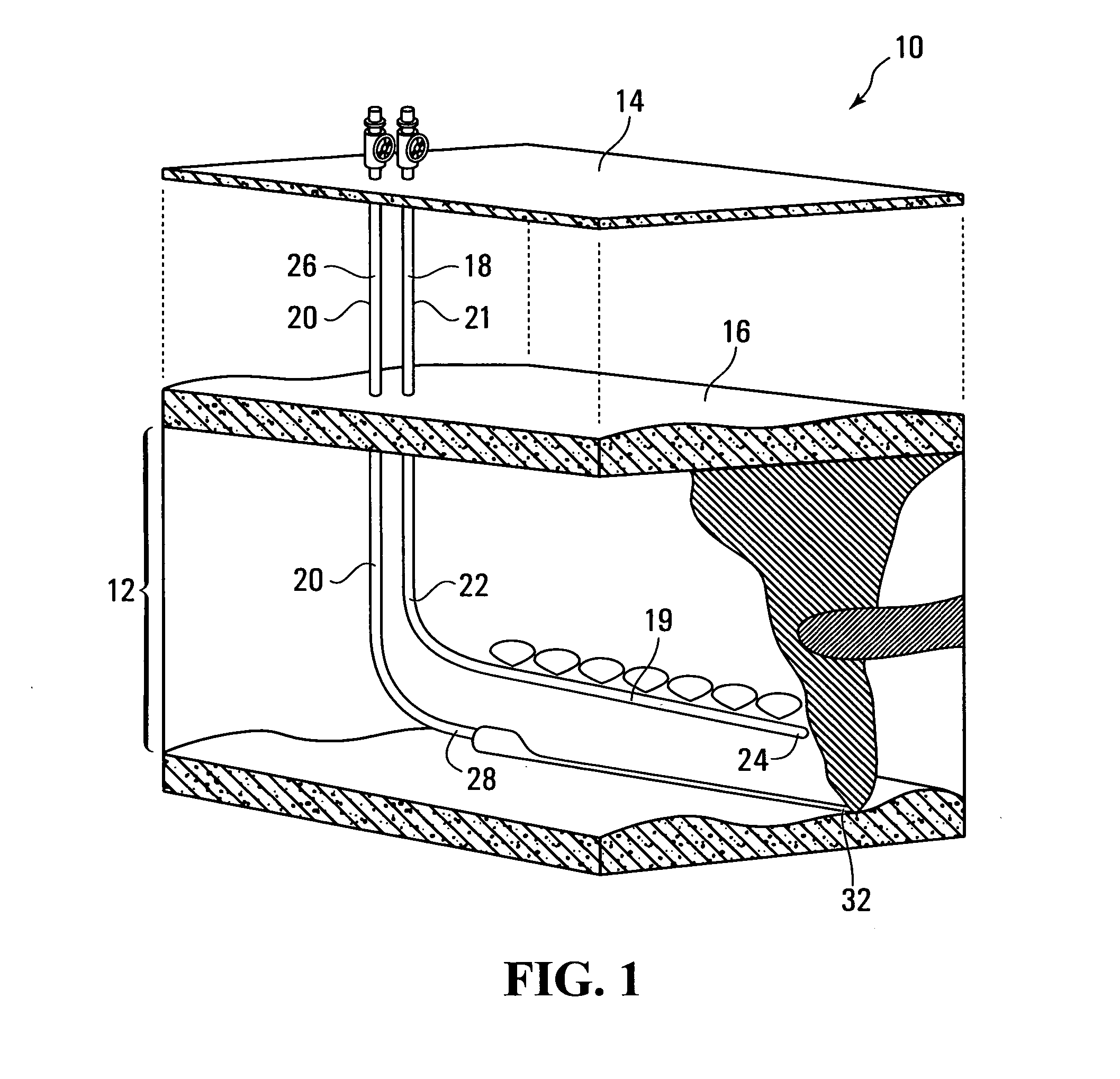[0006]In a first broad aspect, the invention provides a sensor array for measuring one or more physical parameters in a subterranean formation containing a fluid. The sensor array has an elongated outer casing for insertion in the subterranean formation and into the fluid. A first sensor is placed inside the casing for performing a measurement of the fluid at a first location in the subterranean formation. A second sensor is located inside the casing, the second sensor being spaced apart from the first sensor to perform a measurement of the fluid at a second location that is remote from the first location. An optical path, such as an optical fiber links the first and the second sensors. The optical path transporting measurements generated by the first sensor and by the second sensor conveying.
[0007]In a second broad aspect, the invention provides a sensor array for measuring one or more physical parameters in a subterranean formation containing a fluid. The sensor array includes an elongated outer casing for insertion in the subterranean formation and into the fluid. A temperature sensor is located inside the outer casing for performing a measurement of the fluid at a first location in the subterranean formation. A pressure sensor is placed an extremity of the elongated outer casing, the pressure sensor including a deformable component which undergoes deformation in response to a pressure variation established across the deformable component. The pressure sensor also includes an optical fiber connected to the deformable component such that a deformation of the deformable component is communicated to the optical fiber to alter one or more optical characteristics thereof, the optical fiber defining an optical path linking the temperature and the pressure sensors, the optical path transporting measurements generated by the temperature and the pressure sensors.
[0008]In a third broad aspect the invention also provides a sensor array for measuring pressure at a multiplicity of locations in a subterranean formation containing a fluid. The sensor array including an elongated outer casing for insertion in the subterranean formation and into the fluid. A plurality of pressure sensors are mounted at spaced apart locations on the array to provide pressure measurements a different locations within the subterranean formation. Each pressure sensor including a sealed area within the elongated outer casing maintained at a reference pressure and a deformable component within the elongated outer casing exposed to a pressure differential between the reference pressure and pressure of the fluid, the deformable component undergoing deformation in response to variations of the pressure differential. An optical pathway is coupled to the deformable component, whereby deformations of the deformable component alter one or more optical characteristics of the optical pathway.
[0009]In a fourth broad aspect, the invention provides a device for measuring pressure in a subterranean formation containing a fluid, the device including an elongated outer casing for insertion in the subterranean formation and into the fluid and a deformable component inside the casing, the deformable component undergoing deformation in response to a pressure differential established across the deformable component. An optical path is also provided in the casing. A mechanical link is provided between the optical path and the deformable component, the mechanical link altering one or more parameters of the optical path in response to deformation of the deformable component.
[0010]In a fifth broad aspect, the invention provides a system for computing a property of an extraction installation having a subterranean formation containing a fluid and a well. The system has a sensor array in the well, the sensor array including a plurality of spaced apart temperature and / or pressure sensors for measuring temperature and / or pressure at a plurality of locations in the subterranean formation. The system also includes a data processing system connected to the sensor array to receive measurements from the sensor array, the data processing system including a CPU, a machine readable storage in data communication with the CPU and a user interface, the machine readable storage being encoded with a program instructions for execution by the CPU to compute one or more values of a property of the extraction installation. The computation uses as a factor the temperature and / or pressure measurements from the sensor array and a balance selected in the group consisting of mass, energy and momentum of the fluid in the subterranean formation.
[0011]In a sixth broad aspect the invention includes a method for computing a property of an extraction installation having a subterranean formation containing a fluid and a well. The method includes placing a sensor array in the well, the sensor array including a plurality of spaced apart temperature and / or pressure sensors for measuring temperature and / or pressure at a plurality of locations in the subterranean formation. The method also includes providing a data processing system connected to the sensor array to receive measurements from the sensor array, the data processing system including a CPU, a machine readable storage in data communication with the CPU and a user interface, the machine readable storage being encoded with a program instructions for execution by the CPU to compute one or more values of a property of the extraction installation. The computation uses as a factor temperature and / or pressure measurements from the sensor array and balance selected in the group consisting of mass, energy and momentum of the fluid in the subterranean format.
 Login to View More
Login to View More  Login to View More
Login to View More 


